Company Brochure Design Company Graphic Design
Unless you've been living under a rock your entire life, you've definitely been handed your fair share of brochures. Whether you're trying to drive traffic into a new gym location, showcase a property for sale or get the word out about your business, brochures are powerful and effective tools for engaging and educating any audience. But only if your brochure design is on point.
When it comes to brochures, it's all about the design. A great design will compel your audience to read all about what you're doing. A less-than-stellar design will end up in the trash can.
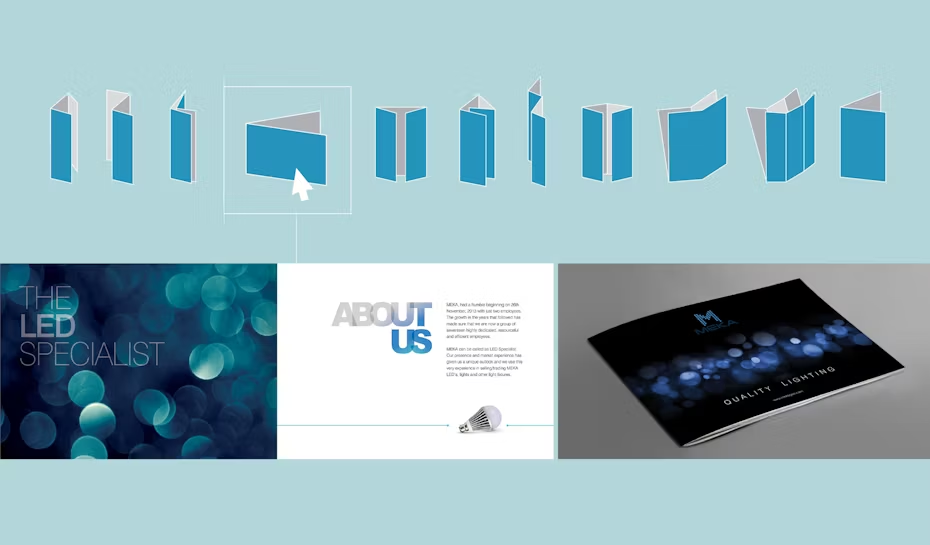
So how, exactly, do you design an awesome brochure? Never fear, we've got the ultimate guide to brochure design. By the end of this post, you'll have everything you need to create, design, and print a great brochure that drives results and makes a lasting impact on your target audience.
How to design a brochure
—
Before you start designing
- Know your brand personality
- Define your ideal customer
- Develop your message
- Determine your metrics for success
- Set your budget
Designing your brochure
- Remember your brand design standards
- Design with the reader in mind
- Choose your brochure type
- Gather your copy and images
- Find your style
- Pick the perfect CTA
Evaluating and printing
- Evaluate your design
- Choose a printer
- Explore print options
Before you start designing your brochure
—
The key to creating an ah-mazing brochure actually starts before you design. When you do the legwork before you start designing—by knowing your brand personality, message, and target customer—you'll make the design process go a lot more smoothly.
Know your brand personality
Do you know who you are? Knowing your brand personality is a must. If you don't know your brand inside and out, all of your branding materials—including your brochures—will feel disjointed and unclear.
For more on how to define your brand personality, check out our in-depth guides on:
- Brand identity
- Personal branding
- Developing a brand for entrepreneurs
Define your ideal customer
Before you start designing your brochure, get crystal clear on who you're designing for. Different audiences require different designs, and if you're not clear on your audience, you run the risk of making the wrong design choices.
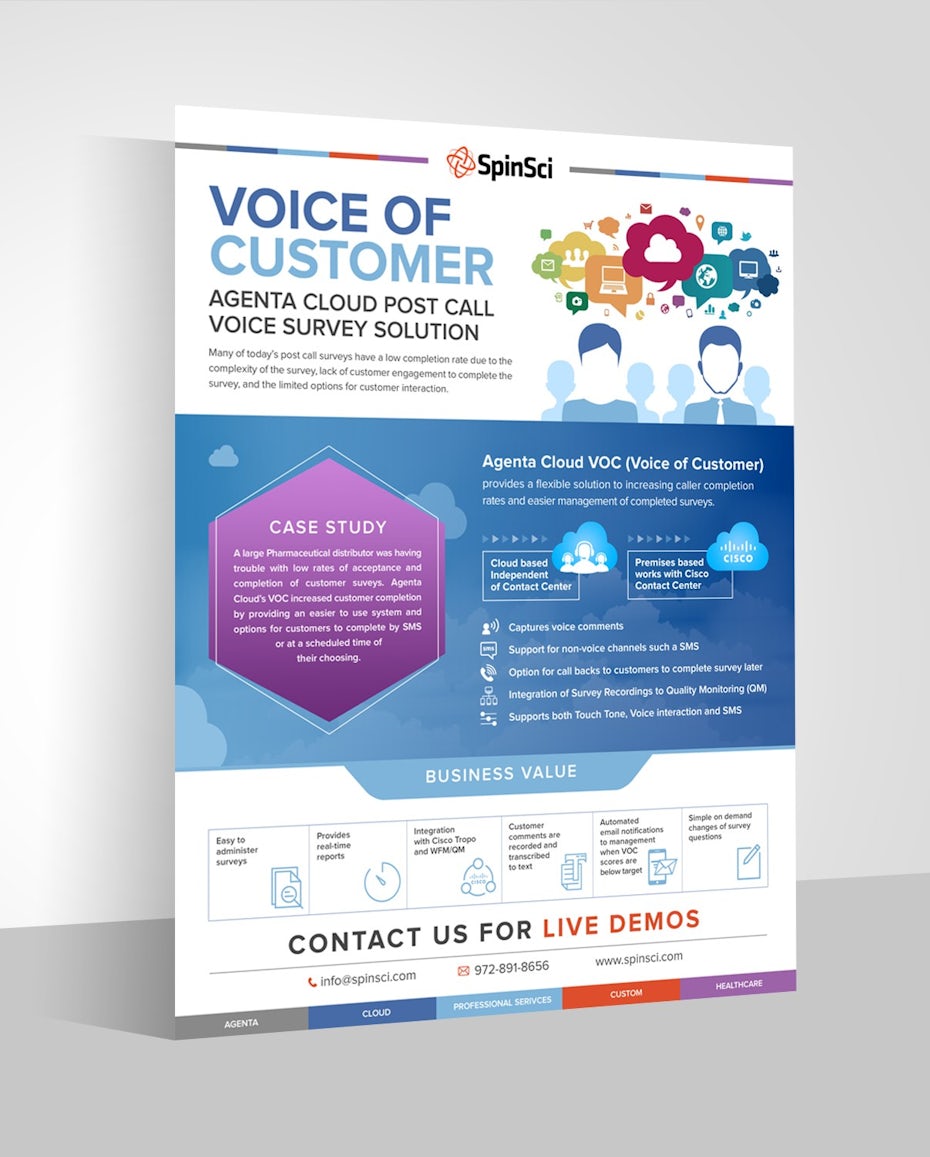
Ask yourself:
- Who is my ideal customer?
- What kind of information are they looking for?
- Are they more likely to respond to more images or more text?
- What kind of copy do they expect? (i.e. Corporate or conversational? Humorous or serious?)
- What can I do to best grab their attention?
When you know who you're designing for, use that to steer your design decisions. You'll end up with a brochure that feels true to them, which will help up your chances of success.
Develop your message
We've just sent you your free brochure ebook.
We touched on this above, but before you design your brochure, it's so, so important that you define your message.
You need to know what you're going to say in your brochure and how you're going to say it before you even think about getting a design in place. Because your message is the most important thing. It all comes back to knowing your customer. If you don't have a strong, clear message that speaks to them in language and images they can relate to, it doesn't matter what design you come up with. Your brochure will fall flat.

For example, let's say you were designing a brochure for new parents to advertise your children's gym. Your message might be: "We're fun and friendly—come join us!" So you want to use accessible, simple, friendly language and bright, vibrant imagery to match your brand and appeal to your target audience. Using complex language likely wouldn't make sense to your customers.
On the flip side, if you're designing a brochure to advertise your services as a financial advisor, your message will likely be quite different, so using simple language and bright imagery could feel too childish, and your ideal client wouldn't take your message seriously.
Know your message before you design so you can make design decisions that strengthen your messaging.
Determine your metrics for success
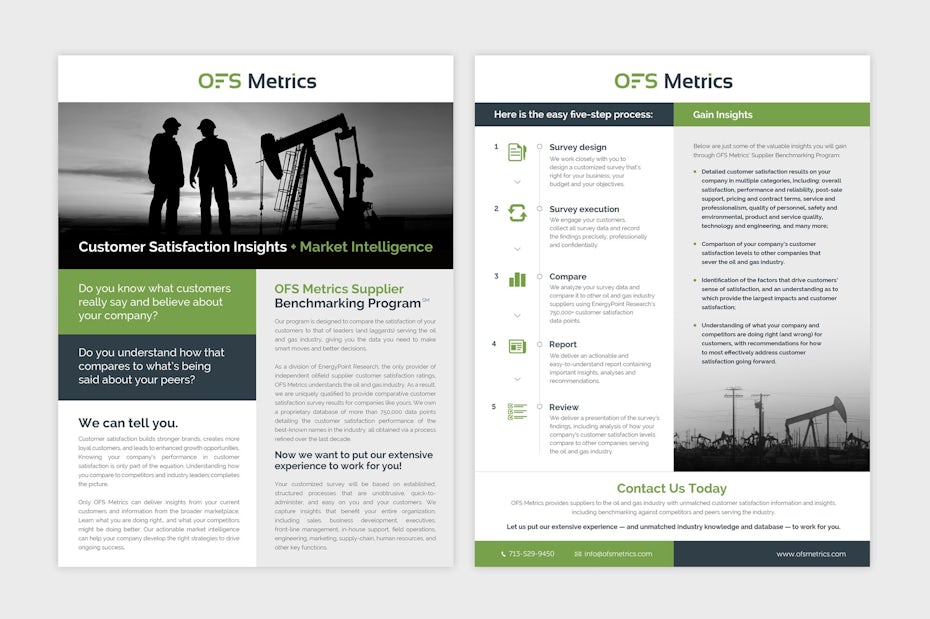
Having metrics in place should be a non-negotiable for every brochure you design. Without metrics, you'll have no idea if you should keep rolling with the same design for future brochures, or if you need to totally overhaul things to drive more results.
Before you design, determine your metrics by defining what you're hoping to get out of your brochure. Here are a few ideas:
- Are you looking to drive people into a retail location? Include a coupon or voucher and measure how many of them are redeemed at your store.
- Are you trying to drive people to your website? Include a custom URL on the pamphlet and track the number of visitors during the campaign.
- Are you trying to build buzz around a new product launch? Include a CTA to sign up for your email list to get updates and see how large your list grows during the campaign.
Set your budget

Your budget is more than just knowing how many brochures you can print. It determines everything from your type of paper to the fun printing techniques you can use to jazz up your brochure.
Come up with a budget-per-print and start making some decisions based on what's most important. Do you need your brochures to be extra sturdy? Invest in a thicker paper. Do you have a cool idea on how to illustrate one of your points? Look at more expensive ink options and printing techniques to bring your visuals to life.
Knowing how much cash you have on hand for the design and printing process will help you make the best decisions for your budget and squeeze the most out of every dollar.
Designing your brochure
—
Remember your brand identity
As you're starting the design process, keep your brand identity front of mind. These elements describe the visual look and feel of your brand, and no matter what kind of brochure you're designing, it needs to be consistent with your overall branding.
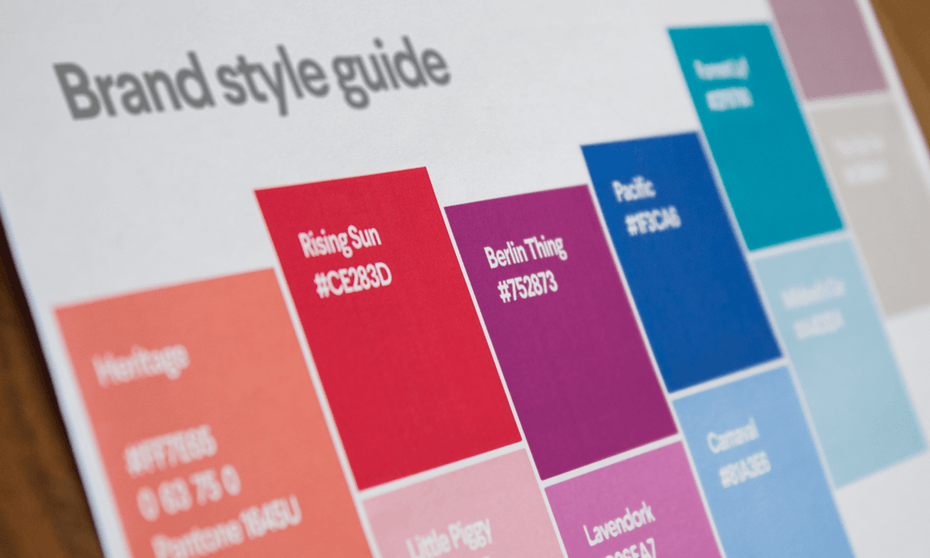
Choose design elements (colors, fonts, and images) that match your brand personality and the tone and content of your brochure. If you've already set your brand color and fonts, make sure you carry them over into your brochure design.
Haven't ironed out your brand design standards? Check out our post on how to create a brand style guide for a how-to.
Design with the reader in mind
As a business owner or designer, it's easy to get caught up in what you want. But, real talk? What you want doesn't actually matter. It's what your customer wants that counts.
When you're designing your layout, keep your reader in mind. How would your ideal customer want to receive information? Are they OK with big blocks of text, or do they need things to be broken up with images so they don't feel overwhelmed? Are their specific colors or fonts that would be particularly appealing to them? Where can you put all of your information (like your business name and contact information) so it's easier for them to find?
When you're designing, make sure to lay things out in a way that appeals to your customer.
Choose your brochure type
You might think "Well, isn't there just one brochure type… you know, like a brochure?" And the answer is no. There's a laundry list of options when it comes to choosing your brochure type and the way it's folded.
According to printing resource Printaholic, there's a whopping 15 ways you can fold your brochure. They include:
The brochure type that's right for your brochure design is 100% going to depend on the content.
You might keep it simple with a Classic Tri-Fold. If you've got a ton of information you need to communicate, go for an option that has more space, like an Eight-Panel Roll Fold or a 16-Panel Fold. If you're doing a step-by-step product tutorial, use a Four-Panel Roll Fold to make your content easy to follow for readers.
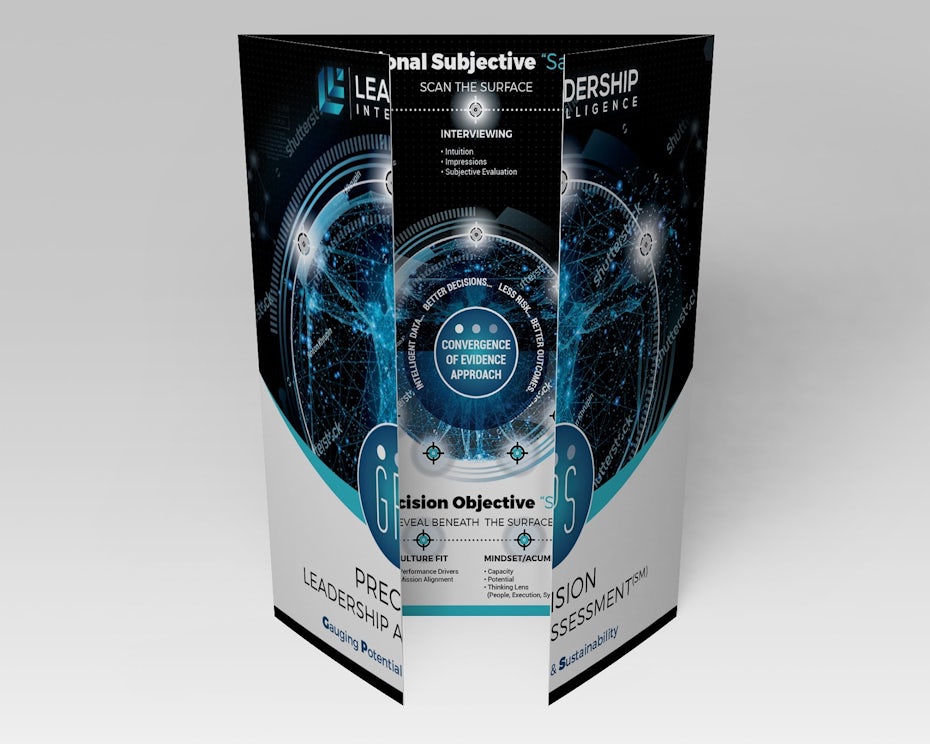
Also consider how your brochure is ultimately going to be delivered.
Are you going to put the brochures on a rack? Are you going to stuff them in a bag with other promotional goodies? Are you going to send them as a mailer? How you plan to deliver or display your brochures will go a long way in determining which fold is the best choice for you and your business.
Gather your copy and images
Have your copy and images ready to go before you start putting pen to paper and creating a design. This will help you make important decisions about layout, length, font size, and more.
But don't get too attached. Chances are that design restrictions will affect how much text or how many images you can include. Be flexible and make sure your main points make it in.
Start with your ideal amount of copy. Including a lot of copy in your design can deliver a lot of information for your readers. However, those huge text blocks can feel overwhelming and actually discourage them from reading. Shoot for something in the middle.
Use headlines and sub-headers to structure your text and make it skimmable for readers who don't have the attention span to read the entire thing (and trust us, they exist). Your headline is especially important. You only get one chance to grab your audience's attention.
Then, do the same with your images. Gather them all in front of you and figure out which ones will help tell your story and where they should be placed. Your images are the first things people will see, so they should help you connect with your reader and illustrate what you do.
As you develop your design, your copy and image selection will likely grow and shrink. Again, be flexible and use these creative elements to tell the story your audience needs to hear.
Find your style
When all is said and done, it's the stylistic elements that are really going to make your brochure shine.
Keep it clean and simple
Graphics! 3D Elements! Glitter! ALL THE TEXT!
If your brochure has too much going on design-wise, it's going to feel totally overwhelming to your reader. You don't want to overcrowd your brochure design with too much text, too many graphics, or too many different design elements that compete for your reader's attention. Keep your design clean, simple, and easy-to-digest for the best results.

Think outside of the box
Stock brochure design… It can be a major yawn.
Consumers these days are savvy. They don't want a bunch of the same old, same old. So if you want your brochure to make an impact on your audience, it can't look like every other brochure they've had in their hands for the past 10 years.
When it comes to brochures, the best designs dare to be different. What can you do that no one else has done before? The more you rock the boat with your brochure design, the more it's bound to grab people's attention.
Focal point = your CTA
The reason you're designing your brochure in the first place is to encourage your readers to take action. And if you want them to take action, you need to tell them in a big way.
If your CTA is buried in a mountain of text in the last paragraph on the last page of your brochure, guess what? No one's going to see it. If you want your CTA to actually inspire people to take action, make it big, bold, and impossible for them to miss.

Give your CTA center stage. Put it in multiple places on your brochure. Make it so that no matter how far into your brochure they read, they won't miss your CTA. Because the more front-and-center you put your CTA, the more people will actually take action.
Evaluating and printing your brochure
—
Your brochure is designed and you're almost ready to roll it out to the masses. But first, make sure it's perfect.
Evaluate your design
Once your brochure is designed, take your time to evaluate the final product. Now is your last chance to make changes and get your design right.
We've just sent you your free brochure ebook.
Ask yourself:
- Does this design grab my attention?
- Is my messaging clear?
- Does this design point to my CTA?
- Is this brochure in line with my branding?
Ask other people those same questions to get an outside perspective. Show your design to your colleagues, customers, even friends to figure out if you've got a winner. Once you're happy, it's time to get printing!
Choose your printer
Working with a top-notch printer can mean the difference between your brochure design coming to life exactly as you imagined it… Or turning out like some gnarly, bootleg version.
If you can, visit printers so you can see their work in person. Viewing samples IRL will always give you a better idea of what you can expect from your print job than looking at samples online.
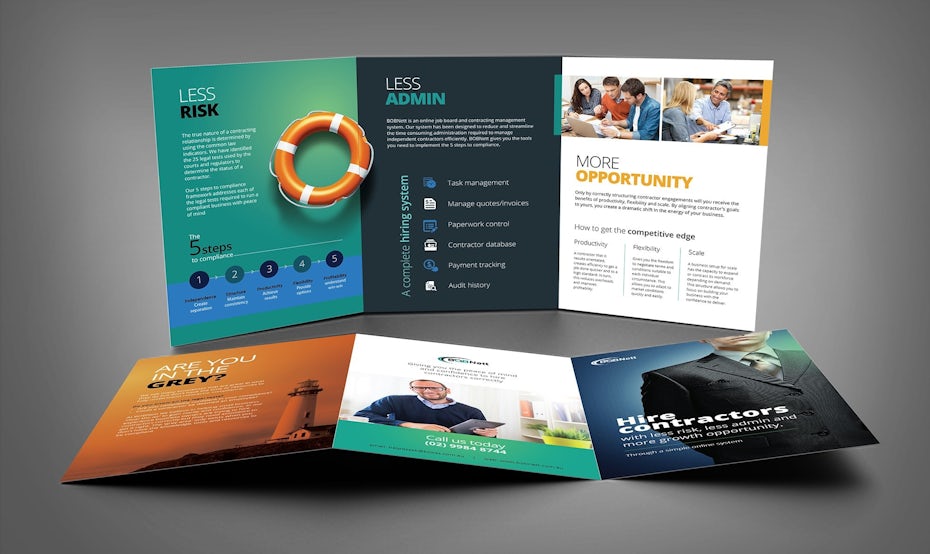
When you're researching printers, ask them questions to see if they're going to be the best fit for your job. Here are a few examples:
- What are your ink options?
- What is your best printing option for time? For cost?
- Do you do color matching?
- Do you offer printed or digital proofs?
- What happens if I'm not satisfied with my print job?
- Do you have designers in-house?
- Do you have experience in brochure printing and design?
- Can you provide references for other brochure clients?
Ideally, find a printer who has experience in the brochure space, uses the latest print technology and has designers on staff who can help with any design issues so your print job comes out looking A+.
Choose your print materials
Work with your printer to select the best materials for your brochure. Here's a little cheat sheet to help you on your way:
Paper weight
Generally speaking, the higher the paper weight, the thicker the sheet. There are a few different ways to measure paper weight (like basis weight and mils), but the most common is metric weight, also known as GSM. The GSM is the weight of one sheet of paper cut into a 1×1 meter square.
Just as an FYI, most brochures fall somewhere between 170 and 300 GSM.
Finish
Once you've chosen your paper, it's time to choose your finish. There are a few different types of finishes to choose from:
Matte: A completely flat finish without any shine
Semi-Gloss: A somewhat shiny finish that falls between matte and glossy
Glossy: A shiny, reflective finish
The finish you choose is all dependent on the look you're going for. Talk to your printer about the different options you have within your budget and what print materials will be the best fit for your objectives.
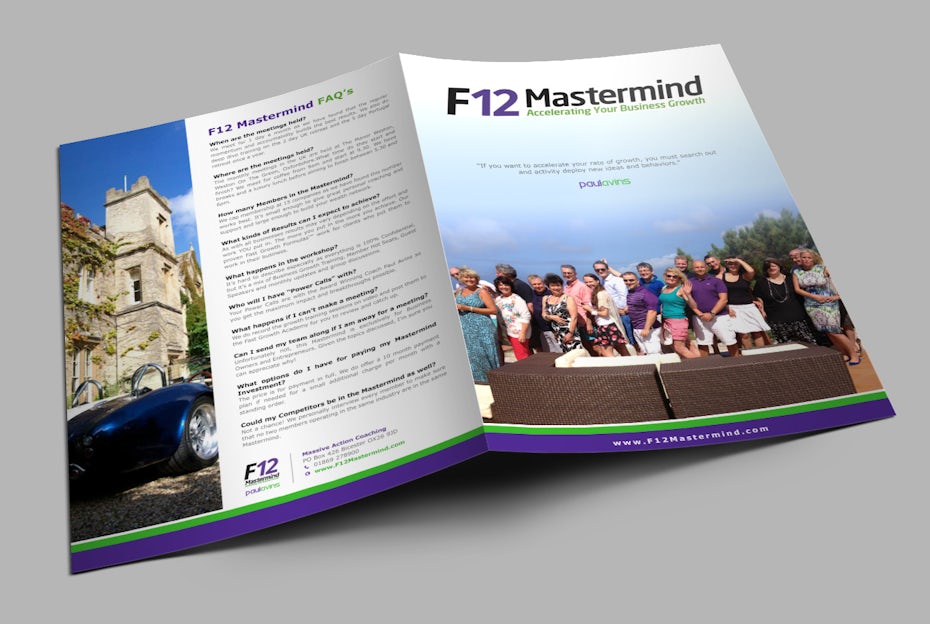
Ink and speciality processes
Some printers also offer specialty inks that can enhance your brochure. Here are a few options you can inquire about:
Foil: A shiny, metallic ink or stamp that reflects light
Embossing: The process of pressing a shape or image into paper to create a raised effect
UV spot: A shiny coating applied only to certain spots of paper (typically a logo, headline, or accents)
Check with your printer if these options (or others) are available and how they might change the cost and production time of your brochure.
Folding things up (yes, that's definitely a brochure pun)
—
You now have everything you need to get out there and design an incredible brochure. One that will deliver your brand message, inspire your customers to take action, and bring you closer to your goals—one brochure at a time.
Wanna see this all in action?
Start a brochure design contest on 99designs.
Company Brochure Design Company Graphic Design
Source: https://99designs.com/blog/marketing-advertising/brochure-design/